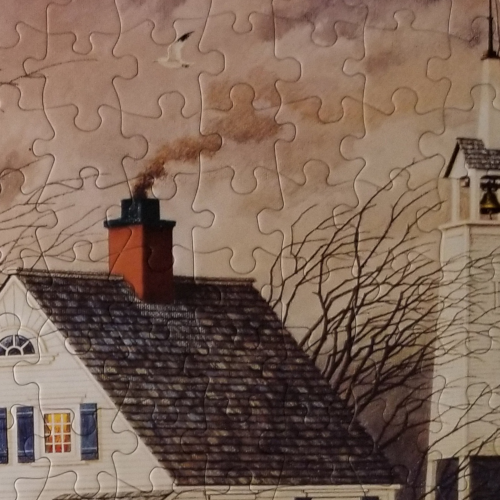Different Jigsaw Puzzle Cuts I Have Seen
After putting together 45 puzzles in the past few months, and trying 8 different brands of puzzles, I thought it would be interesting to show the different cuts that I have encountered. I think these variations pretty much cover all the main possibilities, but I might be wrong.
Ribbon Cut
A puzzle with a ribbon cut has pieces arranged clearly in rows and columns. You can calculate the number of pieces in the puzzle by counting the pieces on the side and the bottom and multiplying them together. Sets of 4 adjacent pieces meet at a point, making a cross. Pieces also share borders with only 4 other pieces. The brand I have done the most of with this cut is Buffalo Games and Puzzles. Here is an example:
You can see that 4 adjacent pieces meet at a point and make a cross in every case. I find this useful because it is helpful to prevent a false fit; often when you make a false fit the surrounding pieces will not meet at a clearly defined corner. Nearly all pieces in a ribbon cut are more or less rectangular (except edges of course).
All the pieces are essentially rectangular, and all sets of 4 adjacent pieces meet at a cross and form a larger rectangle. All interior pieces share a border with 4 other pieces. In the Kodak example pieces generally are either "square" (roughly the same size in each dimension) or "rectangular" (with one axis clearly longer than the other). The rectangular pieces are nearly always arranged with the long axis pointing vertically. Though the difference can be subtle it is often detectable. This fact can sometimes be useful in looking for the next piece.
And here is a final example from Ravensberger:
The Ravensberger pieces have a little more variation in size and shape, but they are still arranged by rows and columns, and 4 neighbor pieces meet at a cross.
There are puzzles which are ribbon cut which have only 1 basic shape on the inside, where every piece has 2 "knobs" and 2 "holes" on opposite sides in the shape of an "H". I have some of these in my to-do pile but I keep putting off doing them because I don't anticipate that cut is going to be a lot of fun, and expect there to be more than the usual number of false fits.
"Random" ribbon cutA variation of ribbon cut which I find interesting is what I will call a "random ribbon cut". Here the pieces are arranged in rows and columns, so you can still calculate the number of pieces in the puzzle by multiplying the number of pieces on the bottom and the side together. However, the piece shape is more irregular, and often only 3 pieces will meet at a point instead of 4, though there will be cases where 4 pieces meet at a cross. A brand with this cut which I like is White Mountain, as seen here:
Adjacent pieces with this cut will often meet along a curved segment. Interior pieces may share a border with more than 4 other pieces (one piece in the example above has 8 neighbor pieces sharing a border).
I find puzzles with this cut to be more challenging to put together than the straight ribbon cuts (ignoring variations in subject matter etc. which can add difficulty). You have to be more careful of false fits also, since two adjacent pieces may not share a corner.
Here 4 pieces sometimes meet at a cross, and sometimes not, but it is always close. The pieces are all essentially rectangular in shape, and there are no pieces meeting at a corner on a curve.
The brand I think of first when I think of random cut is Bits and Pieces. Their puzzle pieces are all irregularly shaped, and you cannot calculate the number of pieces in the puzzle by counting the pieces on the edges and multiplying. Many or most of the shapes are not rectangular, and many are triangular in shape. Here are examples of Bits and Pieces random cut:
There is no arrangement of rows and columns. Sometimes four pieces will meet at a point, and sometimes only three. There are often curves which extend across multiple pieces. It is much more difficult to sort by piece shape. Finally, I find puzzles with this cut to generally not fit as firmly together as the ribbon cut, though there can be exceptions in individual cases.












Comments
Post a Comment